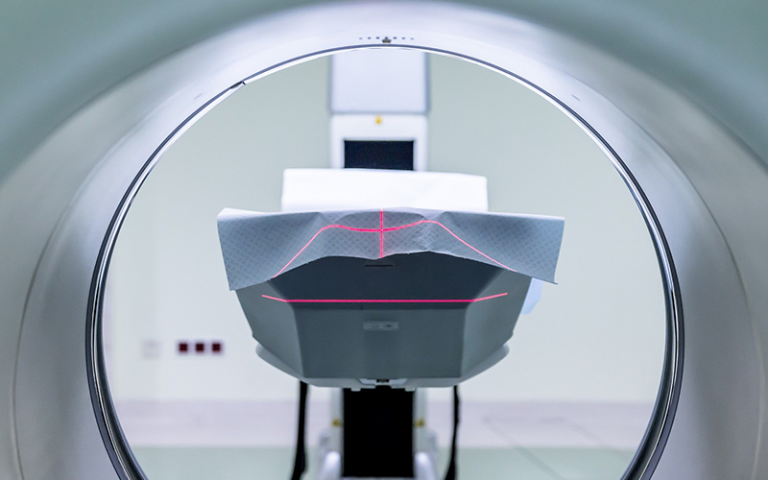Some men with testicular cancer may benefit from fewer CT scans
24 February 2021
Patients who have had treatment for early-stage testicular cancer could benefit from fewer monitoring scans, reducing the harmful radiation they are exposed to from computerized tomography (CT) imaging, according to the results of a new clinical trial involving UCL researchers.

Funded by Cancer Research UK and led by researchers at UCL, The Institute of Cancer Research, London, and Leeds/Huddersfield, the study found that using magnetic resonance imaging (MRI) instead of CT scans was as effective at picking up signs of cancer relapse.
Currently, those with stage one testicular seminoma, which accounts for 40-50% of cases, have surgery to remove the affected testicle, and are monitored to see if the cancer has come back by having regular CT scans for five years. While essential, having a CT scan exposes patients to some radiation, which may slightly increase their risk of developing other cancers later on in life. Using fewer CT scans, or swapping these for MRI, could reduce the amount of harmful radiation patients are exposed to.
Doctors therefore want to find out if patients can have fewer CT scans, or MRI scans instead, without seeing an unacceptable increase in cases where the cancer is only detected in its advanced stage.
In the largest study of its kind, The Trial of Imaging and Surveillance in Seminoma Testis (TRISST) enrolled 669 people with stage one testicular cancer who had surgery to remove the affected testicle. Patients were monitored either using the standard seven CT scans, three CT scans, or the same two regimes using MRI scans.
Results showed that 82 (12%) of the 669 participants saw their cancer return, but only a small proportion (10 people) had advanced stage disease at detection. The majority of relapses happened within three years (all but five patients), suggesting that scanning beyond three years may be unnecessary.
Dr Fay Cafferty, project lead (Medical Research Council Clinical Trials Unit, UCL) said: “These are relatively young men and, for most, their cancer won’t return. So striking the right balance with monitoring is crucial to avoid unnecessary radiation exposure and stress associated with hospital visits. TRISST has shown that relapses can still be detected at an early stage, and successfully treated, with fewer scans, and when using MRI rather than CT. These results will help to shape care for men with this type of cancer in future, allowing us to reduce their exposure to potentially harmful radiation whilst still providing effective monitoring.”
When comparing the number of relapses that were detected at advanced stage, nine (2.8%) were found in the three-scan group compared with one (0.3%) in the seven-scan group. While this shows that some of the more advanced-stage relapses could have been detected earlier if given seven scans rather than three, all of those who relapsed were treated successfully. This indicates that the benefit of having more scans didn’t outweigh the risks associated with additional radiation exposure
When comparing the two types of scans, relapses tended to be detected at a more advanced stage with CT (eight [2.5%]), compared with MRI (two [0.6%]), but the difference was not significant, and all patients in both trial groups were treated successfully.
Professor of Urological Cancer and study co-lead author Professor Robert Huddart (The Institute of Cancer Research, London) said: “When looking at a young population of men who are unlikely to die from testicular cancer, avoiding unnecessary radiation exposure is vital.
“We found that the benefit of having continued CT scans beyond 3 years was outweighed by the potentially harmful exposure to radiation, given the small number of men who relapse and our success at treating those patients. Our study also found that MRI could have real benefits for men with testicular cancer in achieving similar outcomes to CT but with lower doses of radiation. Reducing the number of scans men have could help alleviate the anxiety that some patients experience, as well as easing pressure on the NHS.
“We are now collecting health economic data to see if using 3 MRI scans could be recommended as the standard surveillance plan.”
Michelle Mitchell, chief executive at Cancer Research UK, said: “Survival for early-stage testicular cancer is almost 100%, which is great news. With almost all men being treated successfully it means optimising monitoring after surgery could have a huge impact, not just in terms of detecting relapse at a point where treatment is most likely to be successful but minimising potential harms that may come from scans. We will be eagerly following the next steps of this trial to see whether using fewer CT scans or MRI could be the new standard of care.”
Researchers will build on the early findings of the study and will explore the cost and effectiveness of MRI scans.
Links
- The TRISST clinical trial results
- Dr Fay Cafferty’s academic profile
- MRC Clinical Trials Unit at UCL
- UCL Faculty of Population Health Sciences
- Cancer Research UK
- The Institute of Cancer Research
Image
Source: Pixabay
 Close
Close

